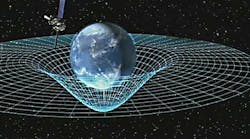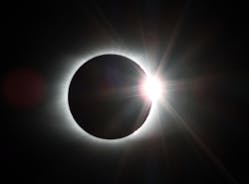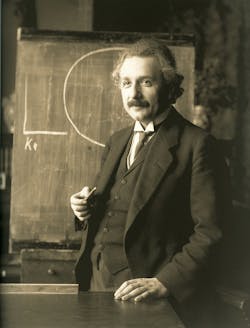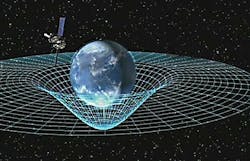The eclipse this year reminded me of a couple famous eclipses around 100 years ago that changed the way we view the universe. Einstein’s Theory of Relativity was paradigm-shifting, and proving it seemed like a miracle. From cloudy skies to the first World War to a hot jungle, the phrase “Genius is 1% inspiration and 99% perspiration” was true for this universe-altering moment.
In 1914, Erwin Finlay-Freundlich and William Wallace Campbell got onto a train with hundreds of pounds of equipment. Their goal was to photograph a solar eclipse to get evidence of Einstein’s theory. To prove the theory, light (star light) passing by a large mass (the sun) would bend. A photograph of star light passing close to the sun should show to be out of place compared to viewing it when the light didn’t pass by the sun.
To increase their chances of a paradigm-shifting photo, Campbell headed toward Kiev while Freundlich took off to Crimea. Once the equipment was set up, there was nothing to do but wait. Unknown to these scientists was that on June 28,1914, Austrian Archduke Franz Ferdinand was assassinated in Sarajevo, Bosnia, which essentially started WWI.
Fun fact: Newton’s theory was accurate enough to disprove itself. Scientists used Newton’s math to find the path of totality in order to get the pictures that would prove Einstein was right and Newton’s theory wrong.
Both camps were stopped by Russian soldiers. Freundlich not only was shut down, but since he was German, he was taken as a prisoner of war. Campbell was an American, and at this point, the U.S. was a neutral country. He was permitted to continue. The eclipse came and so did the clouds, thwarting the attempt. Campbell was allowed to return to America, but he had no evidence and no equipment—it was confiscated by the Russian army.
The war killed communication between the scientists and halted scientific development for years. Ties were eventually cut—Campbell now saw his colleagues from Germany as the enemy. With a negative view of the war, Einstein realized there were things bigger than physics. Taking a stand against the war, Einstein wrote a manifesto against it, but no one joined the cause. This alienated Einstein, who used the isolation to focus on his work.
Had this isolation not occurred, Einstein may have never noticed his mistake. If the observations of the eclipse happened, it would have shown that light only bent about half of what was predicted by the theory. This would have discredited Einstein and killed the Theory of Relativity.
Shedding New Light on the Math
There is no wiggle room for the Theory of Relativity. If a photo of an eclipse showed that the light didn’t bend precisely to how the math predicted, it would be wrong and dismissed. The setbacks in proving the theory might have become a good thing for Einstein and the scientific community.
Albert Einstein (Credit: Ferdinand Schmutzer - archived copy (image), Public Domain, Wikipedia)
In reworking the math, he noticed everything seemed to be pointing to something he had dismissed years ago. In 1912, Einstein stopped working some equations because they were just too unfamiliar. He realized he might be able to not only fix his equation, but explain something that has confused astronomers for years.
Mercury’s orbit deviated from Newton’s physics. Einstein painfully calculated Mercury’s orbit, and the math matched his theory. Unfortunately, at the same time David Hilbert—one of the most influential mathematicians of the 19th century—also figured out how to fix the equations. Fortunately, though, Hilbert was gracious and gave credit to Einstein.
All of this was done just in time for Einstein to present at the prestigious Prussian Academy of Sciences. However, without proof, relativity only had so much power, and the next eclipse wasn’t until 1918. This eclipse would pass right by Lick Observatory, where Campbell worked, but his equipment was still in Russia. Furthermore, no one else could travel to the U.S. to see the eclipse because the war was still going on. It was all up to Campbell.
Improvised equipment was made from parts around the observatory. It worked! This time the images collected could be used to measure the position of the stars. The measurements are extremely small and must be precise. Einstein predicted the difference in the location of the stars would be much less than a millimeter. The makeshift equipment yielded a result—Einstein’s theory was wrong.
Campbell had to be certain, and ordered the measurements to be taken over and over, until 1919 when Campbell announced his findings to the Astrological Society. Moments after presenting to the society that the Theory of Relativity was wrong, a communication came over the wire from Arthur Eddington. Upon seeing the note, Campbell sent a historic cable of his own to his colleagues in the U.S., “Delay publishing Einstein results.”
Welcome to the Jungle
Eddington sympathized with Einstein and wanted badly to show the world that science could not be stopped—with or without a war. So in 1919, he went to Africa, hiked deep into the hot jungle, and spent a month setting up a telescope amidst the malaria-infected mosquitos and poisonous snakes. Then after months of journeying and setup, the eclipse came. Unfortunately, so did the rain.
(Credit: NASA [Public domain], via Wikimedia Commons)
The clouds covered the eclipse and when it looked like all was hopeless, the clouds parted just enough to see a black moon. Eddington starting processing photographic plates as fast as possible. In the excitement, he had to be careful with exposure times, making sure the telescope was aligned correctly, and hoping above all that he didn’t leave the lens cap on.
There in the jungle, Eddington found that only a few plates showed any stars. It would take months to make the long journey back to Cambridge, where he worked, to be able to prove anything. Returning home at about the same time Campbell was presenting at the Astrological Society, Eddington knew he had months of calculations to verify his finding.
Admitting he wasn’t 100% positive, but wanting to stop the death blow Campbell was delivering to the theory at the astrological society, Eddington sent a cable. Four months later, Eddington journeyed to the Astrological Society. In a crowded room, Eddington pointed at the portrait of Sir Isaac Newton and stated: “Forgive us Sir Isaac Newton, your universe has been overturned.” In that moment, everything we believed about our universe was wrong. Einstein became a science superstar overnight; beers and children were named after him.
But it wasn’t all smooth sailing. There was bound to be push back, and that was certainly the case. Fortunately, the next eclipse was in Australia, and with the war over, seven expeditions went to capture it. Interestingly, most of the expeditions failed. Two got shut out by the clouds, one couldn’t get data because their equipment was poor, and another had technical difficulties. Fortunately, for the world, Eddington was there and knew exactly what to do. His plates showed 92 stars that not only illustrated Einstein’s Theory, but behaved exactly as he said they would.
The universe would be forever changed, and it only took 15 years. Despite this, Einstein would never receive a Nobel Prize for his Theory of Relativity. In 1922, he got a Nobel Prize for the first of his “Annus Mirabilis” papers that described the photoelectric effect. That paper would become the foundation of quantum mechanics, which would ultimately unlock the secrets of the atom. But had it not been for WWI, would Einstein’s career have been destroyed and the secrets of the universe still be unknown today?




